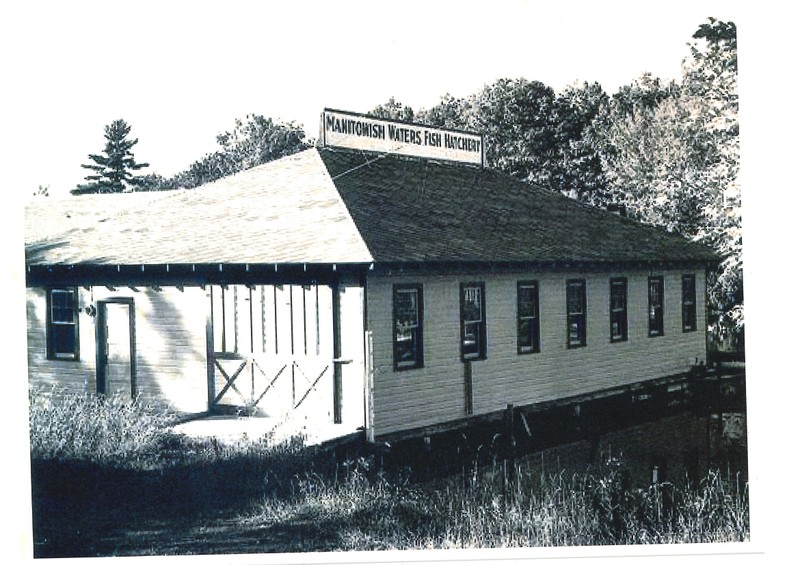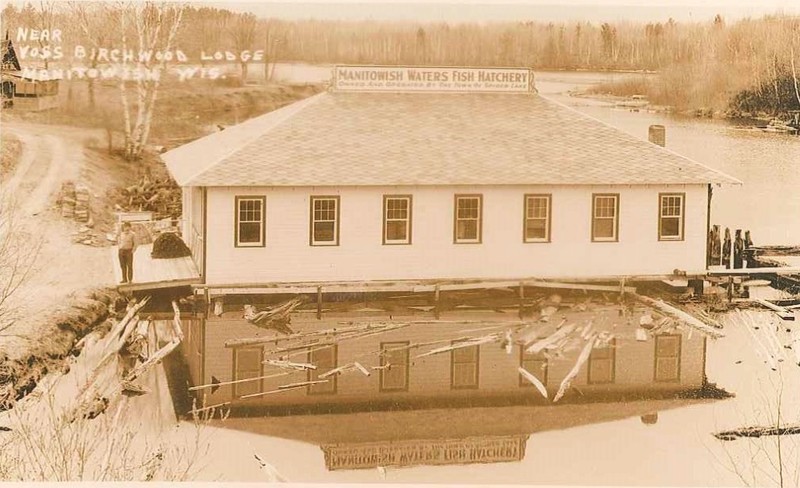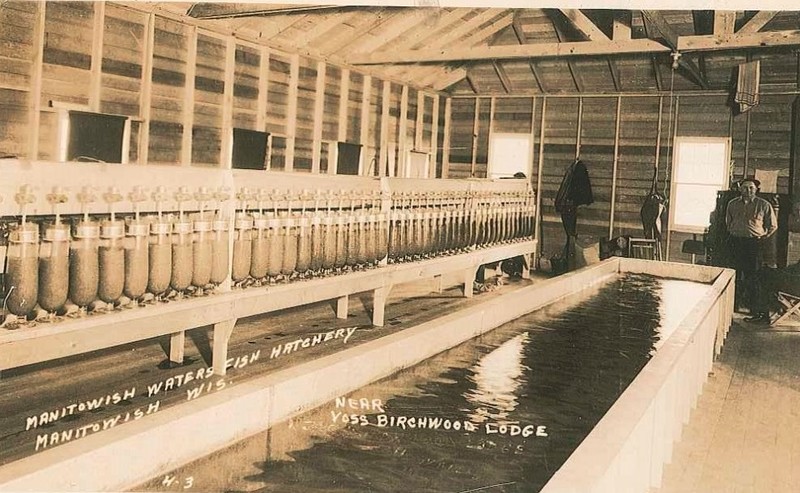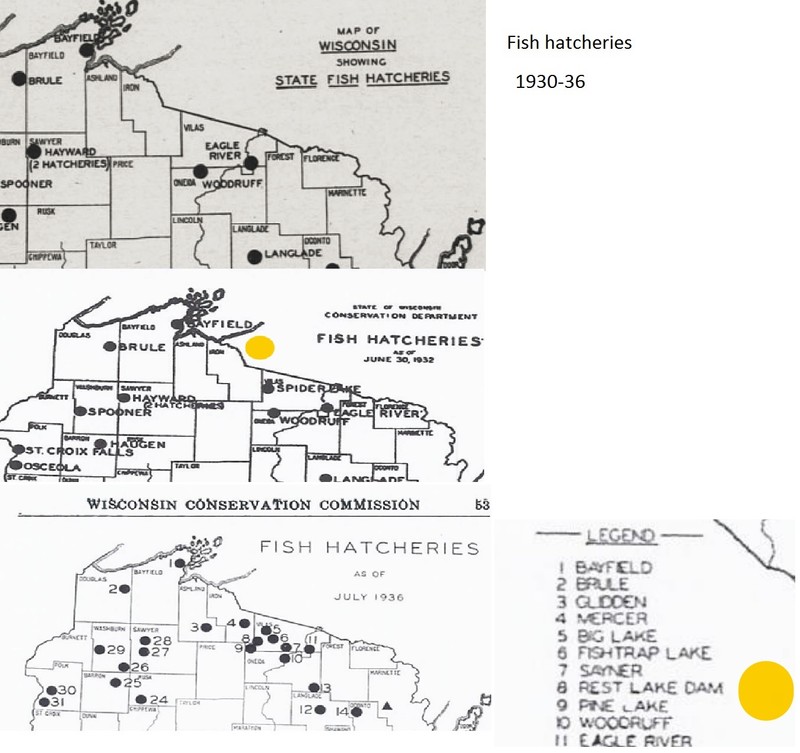Manitowish Waters Fish Hatchery
Introduction
Text-to-speech Audio
Discover how the first municipal fish hatchery in Wisconsin helped Manitowish Waters survive the economic collapse after the stock market crash of 1929.
During the Great Depression, the Wisconsin Conservation Commission was short on cash to stock area lakes. Manitowish Waters stepped up, raising $1000 to construct a fantastic fish hatchery just below Rest Lake Dam. Tourism was the lifeblood of the local economy, and back in the 1930s, fishing was the big attraction. The Manitowish Waters hatchery's success inspired other municipalities like Mercer to follow our model. The hatchery operated into the late 1940s or early 1950s before it closed. Today, the conservation group Walleyes For Tomorrow conducts similar operations and helps stock Northwoods' lakes.
Images
Manitowish Waters Fish Hatchery

View of MW Hatchery from HWY 51

Interior of MW Fish Hatchery

Wisconsin Conservation Commission reports on municipal hatcheries

1948 Downstream view of the MW fish hatchery

Fyke nets live trap walleyes to strip eggs and milt for hatcher

Large female walleye being released aster being stripped of eggs

Backstory and Context
Text-to-speech Audio
The site of the Manitowish Waters Fish Hatchery was just north of the Pea Patch Saloon and an important historic Manitowish Waters destination.
Northwoods fishing continues to attract thousands of tourists each year to Manitowish Waters and the surrounding region. Even before highways, sportsmen and sportswomen would travel by rail to their favorite fishing destination. Some of the trains were actually called, "the Fishermen Special." As hard times fell upon America during the Great Depression, Northwoods' communities competed for scarce tourist dollars.
The town of Spider Lake (becoming Manitowish Waters in 1940) took the initiative to reach out to the Wisconsin Conservation Commission and enter into a public/private partnership to establish the Manitowish Waters Fish Hatchery. This effort was likely spearheaded by conservation activist and resort operator Alvin Koerner. Locals, working with Wisconsin Conservation Commission staff, would collect the eggs from fish in the spring, hatch the fish fry, feed the fish in rearing tanks or ponds, and ultimately release the fish into the Manitowish chain of lakes.
Posts below the Rest Lake Dam remain and outline the old fish hatchery.
A few years after the success of the Manitowish Waters Fish Hatchery other communities began to construct their own hatcheries with the support of the Wisconsin Conservation Commission. The Civilian Conservation Corps also began to construct new hatcheries and rearing ponds to propagate different species of fish and allowing fish to grow throughout the summer. Circle Lily Creek, Rice Creek, Plum Creek, Fish Trap Dam and Lake of the Falls represent Northwoods' Depression Era fishery sites.
The entire town celebrated as the fingerlings would be transported in large milk containers to selected lakes. The milk containers held just enough oxygenated cool water to keep the fish healthy. Boats would move the fish into deeper water to release the fish, dispersing the new fish and protecting them from shoreline predators like blue herons or sea gulls.
Today, area anglers are challenged by declining fish populations. Groups like Walleyes For Tomorrow use their fundraising networks to recreate the magic of the 1930s municipal fish hatcheries that all began below the Rest Lake Dam in Manitowish Waters.
Sources
Wakefield News. June 15, 1935. Newspapers.com. Manitowish Waters Historical Society PastPerfect Online. Manitowish Waters Historical Societyhttps://mwhistory.pastperfectonline.com/Archive/564F8E7A-B473-4048-8AD1-211615525100.
Wisconsin Conservation Commission, Biennial Report 1929-30. Page 57. Manitowish Waters Historical Society PastPerfect Online. Manitowish Waters Historical Societyhttp://ppolinks.com/mwhistory/1929-30%20Biennial_Report_of_the_State_Conservation%20Com.pdf.
Wisconsin Conservation Commission, Biennial Report 1931-32. Page 73. Manitowish Waters Historical Society PastPerfect Online. Manitowish Waters Historical Society http://ppolinks.com/mwhistory/1931-32%20%20Biennial_Report_of_the_State_Conservation%20Com.pdf
Wisconsin Conservation Commission, Biennial Report 1933-34. Page 49. Manitowish Waters Historical Society PastPerfect Online. Manitowish Waters Historical Society http://ppolinks.com/mwhistory/1933-34%20Biennial_Report_of_the_State_Conservation%20Com.pdf
Wisconsin Conservation Commission, Biennial Report 1935-36. Page 53. Manitowish Waters Historical Society PastPerfect Online. Manitowish Waters Historical Society http://ppolinks.com/mwhistory/1935-36%20Biennial_Report_of_the_State_Conservation%20Com.pdf
MWHS archives
MWHS archives
MWHS archives
MWHS archives
MWHS archives
MWHS archive
MWHS archives
